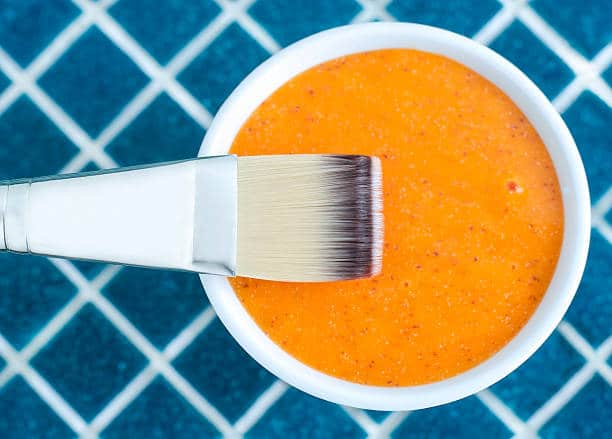This post was last updated on November 21, 2022 by Preethi Sukumaran
A good ayurvedic face mask can clarify the skin, revitalise the Srotas, correct minor Dosha imbalances and help you in your skin care routine. But how do you apply an Ayurvedic face mask correctly? Should you wet your face before applying a face mask? Should you be applying anything to your face after washing of the face mask? How do you make sure you are applying your face mask correctly. Is there a difference between an ayurvedic face wash and a face lepa?
The internet is rife with helpful (actually pretty unhelpful advice and tips ) on using a face mask correctly.
Much of the advice we’ve seen online is erroneous and can actually harm your skin if done regularly. These include washing the face with warm water AFTER using a face mask, or applying another astringent product like a toner after a mask.
Ayurveda recommends only to use cool or room temperature water on facial skin. Hot water / warm water is not suggested for the area above the neck as this is a rich catchment area for nerves and fine blood vessels. Excessive use of hot water here can aggravate pitta and cause nerve damage in the long run.
Similarly, the very process of using a face mask cleans out and opens the srotas. Many herbs used in an ayurvedic face mask are already astringent so they have a mild tightening action after use. Therefore in Ayurveda, we are ask to use a nourishing substance on skin after using a face mask and not something that can further dry / over tighten skin like a toner.
Is there a difference between a cosmetic Face mask an an ayurvedic face mask / lepa? Yes , plenty actually.
What is an Ayurvedic face lepa? And how can it help me in my skin goals?
An Ayurvedic face Lepa is so much more than a mere Face Mask. In Ayurveda it is used variously to remove Visha (poisons / toxins ) from the body, to relieve pain and inflammation (Dosaghna) and to improve skin health (Varnya / Twachya).
To help solve skin concerns and help people in their skin goals, an Ayurvedic face lepa is carefully formulated to solve the skin concerns faced in different dosha aggravations.
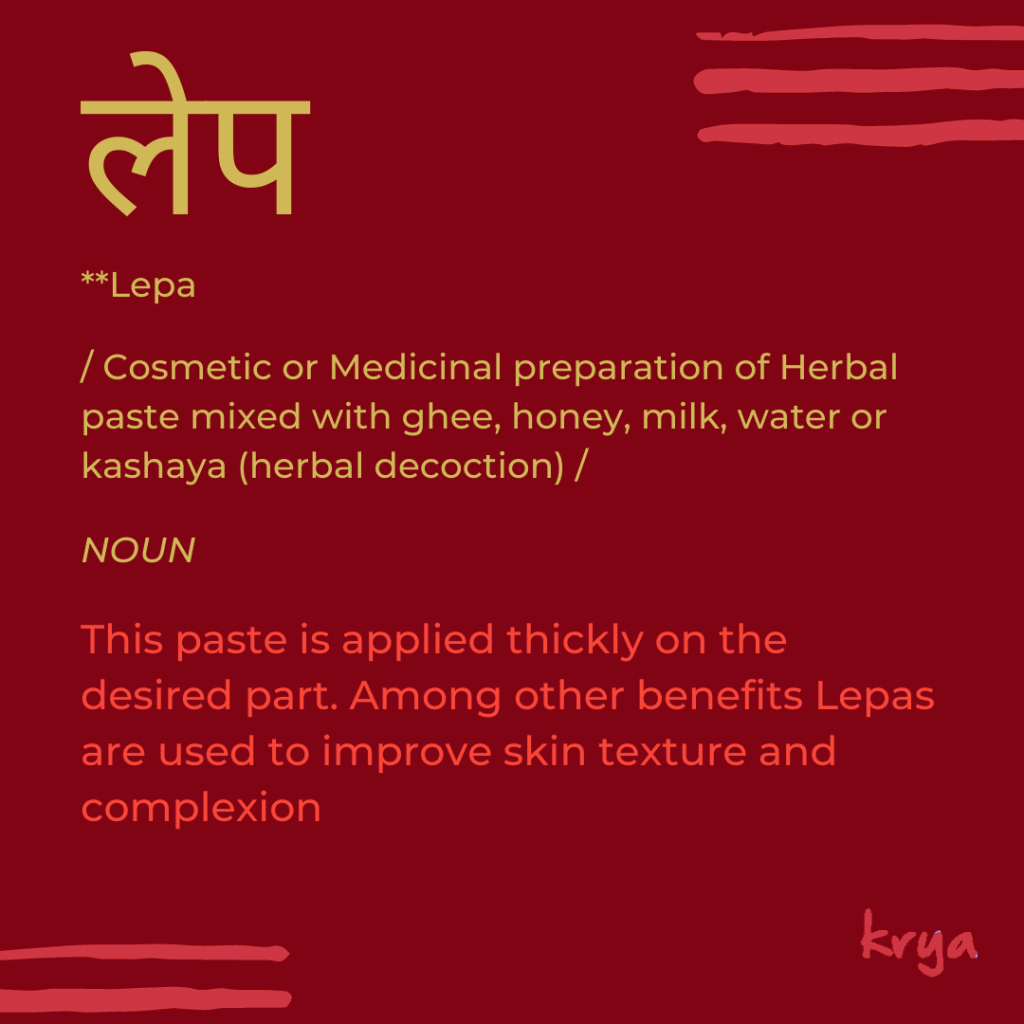
For example, the Krya Classic face Lepa is formulated to help balance excess sebum, oiliness, dull skin and uneven complexion which occurs when pitta is imbalanced. We would call this skin normal – oily in common parlance. To help balance Pitta, we use Pitta balancing herbs like Nimba, Shirisha, Vetiver, Sarsaparilla etc. All ayurvedic face Lepas work at a deep and holistic level.
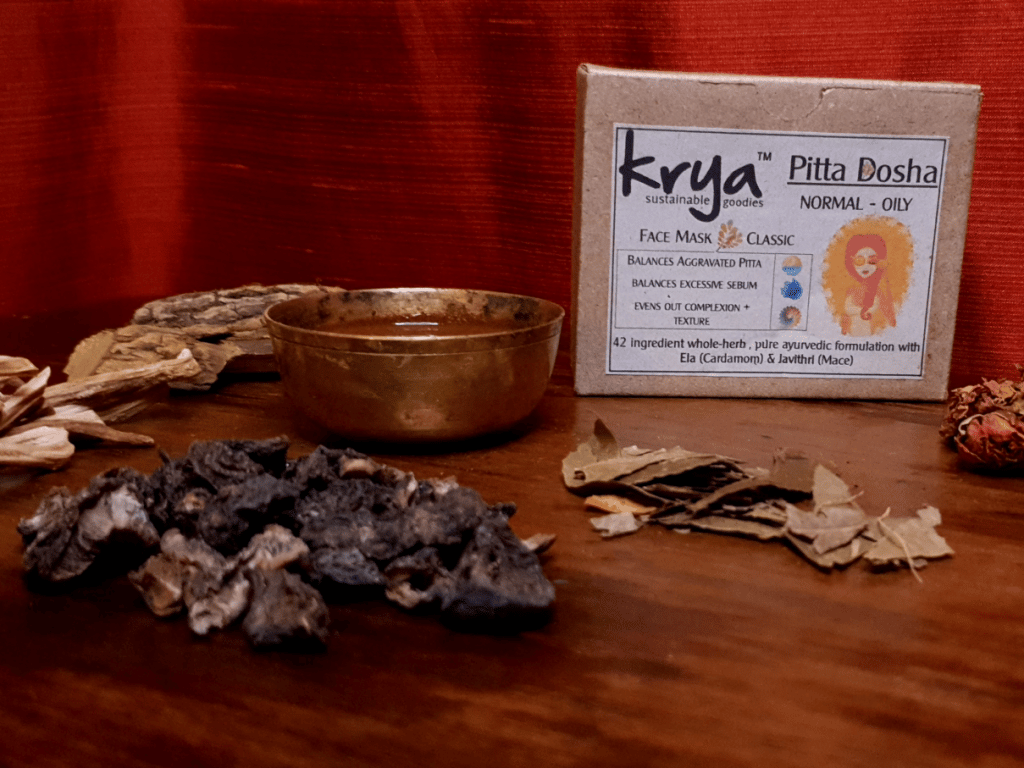
While you do get immediate cosmetic benefits, the effort here is to help the skin at a deeper level. so an Ayurvedic face lepa must form a regular part of your skin regimen , for it to have the right impact on skin. Explore our complete range of Ayurvedic face lepas here.
What are the Srotas in skin?
Skin is a living breathing organ. It is an important organ of thermoregulation and helps adjust body temperature through the process of sweating. It help detoxify the body and supports the kidney in the task of removing wastes / mala from the body.
How does the skin do all of this? By the complex network of Srotas present in the skin. Srotas are minute tubular structures which help transport waste out, deliver sebum and moisturisation to all parts of the skin. Synthetic skin care interferes with the proper functioning of Srotas. Ingredients like silicones in hair products), petrolatum, ceramides in skin care and synthetic moisturising substances can all clog the srotas, preventing the healthy functioning of skin.
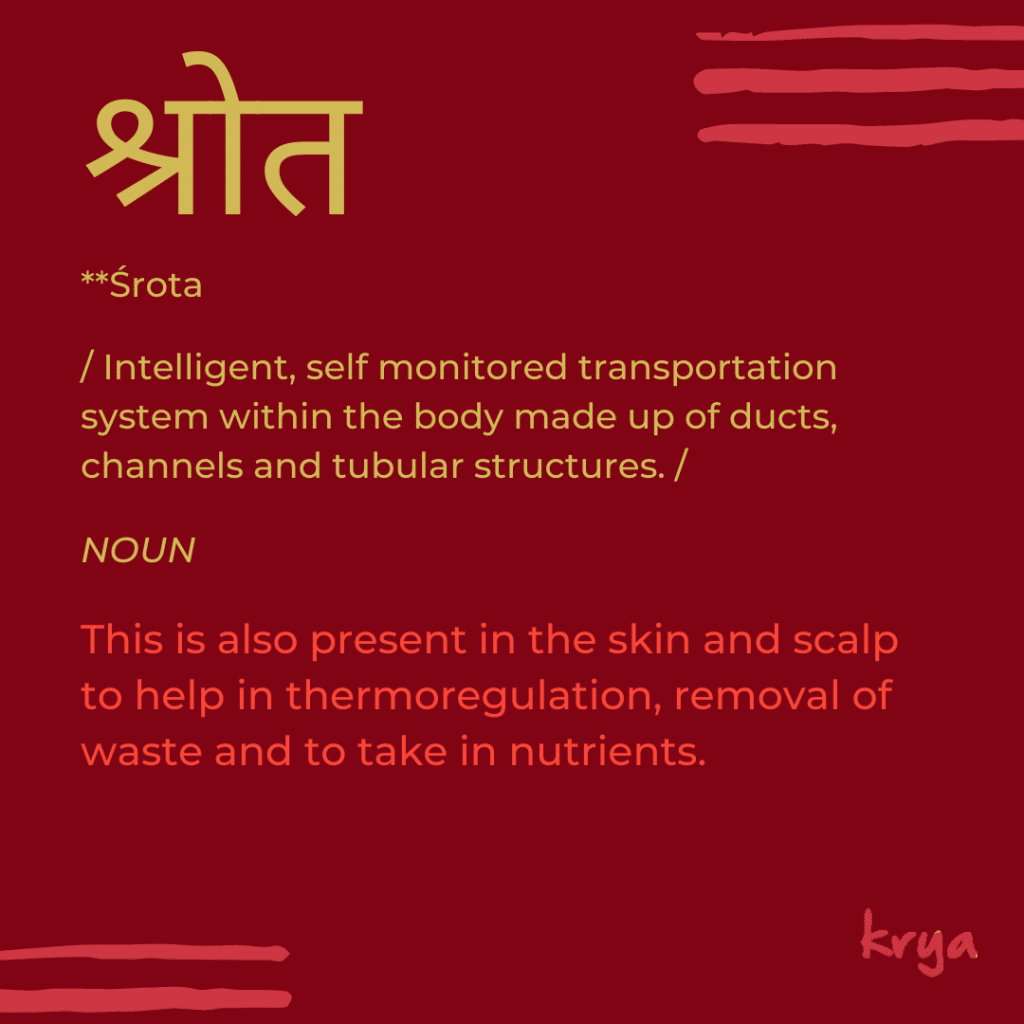
When we choose skin care / make up, it is important to keep our Srotas in mind. Anything that blocks, clogs or interferes with our srotas should not be used. This is also why make up should not be worn for too long and must ALWAYS be removed properly at night. Krya now has an ayurvedic, completely natural make up cleansing skin oil. Please explore this product here.
So how should you apply an ayurvedic face mask or a home made face mask correctly? We have a longer post that details the exact process of applying an ayurvedic face mask correctly here. Here is a shorter checklist with 5 simple face mask tips that can help you.
5 simple tips to help you with your ayurvedic face mask:
-
Apply your Ayurvedic face Mask (Lepa) in the evening
An Ayurvedic Face mask helps draw out excess Pitta from the face region and from around the Eyes. The eyes are an organ system that has high dependence on Pitta and Kapha dosha. Both of these tend to cancel each other out if one is present in excess, so we always have to maintain the delicate balance between the two. When we over use the eyes by using smartphones, laptops , the Eyes over draw on Pitta energy – in the short term this leads to Migraines, cluster headaches, and eye watering. IF not corrected over time it leads to vision problems. A regular Face lepa using Ayurvedic herbs and a regular pada abhayanga both help balance this excess Pitta energy in the eyes.
To soothe the eyes and draw out Pitta built during the day, an ayurvedic face mask should be used in the evening. Applying it in the morning will be sub optimal as we will be working against the build up of solar energy. As pitta tends to balance, the eyes may water or hot vapour may be released after using an ayurvedic face mask. To help this pitta release, the eyes must stay open after applying a Face mask. So it is not advisable to apply the face mask just before going to sleep.
2. Apply the Mask as a thick layer which is atleast 1/2 the width of your thumbnail
Face masks to improve texture, complexion and skin quality should be applied as a thick layer. This allows the slow penetration of the herbs through the minute srotas of the skin. In Ayurveda we always go for “slow and steady” therapy as the acharyas believe in building “sthairya” or stability in any treatment plan. Sthairya means that we should allow the body and the skin to absorb nutrition at its own pace. We do not over engineer products – at all points the body’s innate intelligence and understanding guides us.
The measure of thickness is an “angula” . This is a common measure used across Ancient India from engineering to face masks and lepas. The Arthashastra says that 96 Angula lengths = 1 Danda. And the danda was the standard measurement unit in engineering constructions from Harappan period to the Mauryan period. An analysis of caves (which were engineered) in Barabar & Nagarjuni hills (dating to Mauryan period says that these 2 basic measurement units of Angula and danda were used to design construct the cave.
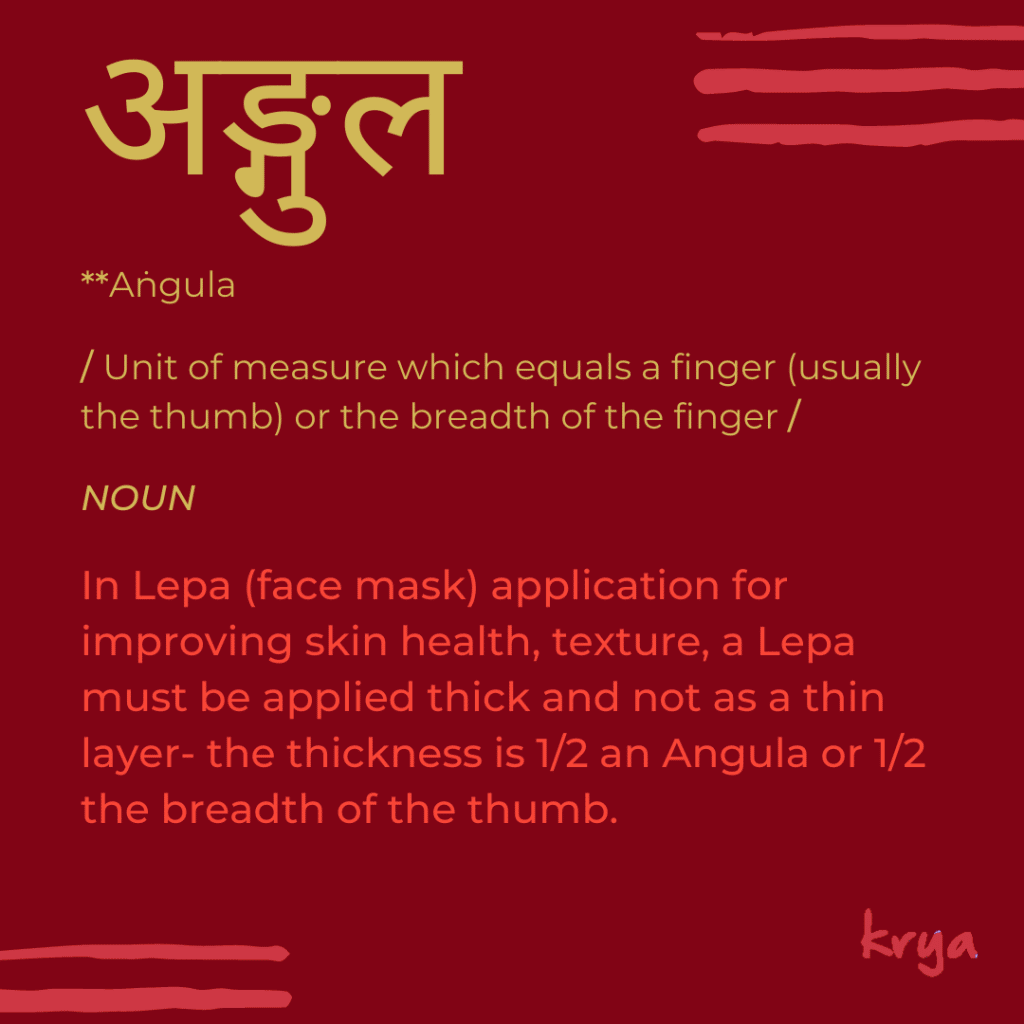
3. Allow the Face Mask to interact with the Anupana (medium) for 30-45 minutes before you apply the face mask
The Anupana is the medium that we use to mix the Mask with. This also acts as a medium to conduct nutrients from the Lepa into the skin through the srotas. In Ayurveda, an Anupana is an “Activator”. The Anupana activates the herbs and helps them penetrate teh skin easily and more effectively. The Anupana by its inherent properties, also adds to and enhances the properties of the ayurvedic face mask.
In Ayurveda, we use a wide variety of anupanas for mixing Face lepas like clean water, A2 cows milk, goats milk, rose water, special herb decoctions / kashayas, fruit juices, etc. The mask and anupana interact with each other over the next 30-45 minutes and the herbs activate within the face mask . So when we apply this mask, its action on skin is deeper and more potent.
4. Rinse out the face Mask before it dries on the face
This is again a piece of advice that flies contrarian to popular internet advice on face masks. a face mask “should dry out on skin. This tightens the skin and pores”. But, Ayurveda tells us that this prematurely ages skin and interferes with the healthy working of Srotas!
Further Ayurveda tells us that face masks are only effective as long as they are damp with moisture. They become ineffective and in fact harmful when the dry out. So ensure you rinse out your home made face mask or your ayurvedic face lepa as it begins to go dry on the skin. Rinse only with cool water – do not use warm or hot water to rinse the mask out.
5. Seal in goodness with an Ayurvedic serum after rinsing out the face mask
What to apply to the skin after rinsing out a home made face mask or an ayurvedic face mask? Do we follow up with a toner or leave it as such? An important part of our ayurvedic face mask tips is to follow up a mask with an Ayurvedic serum. The srotas are cleansed after an ayurvedic face mask treatment. The skin is also in a better state of balance. Now the skin is ready to receive good quality nourishment. A toner will simply shrink and remove moisture. Instead , a nourishing ayurvedic face oil can be used. Krya has a wide range of skin serums for different skin types available.
The Krya Classic skin serum suits normal – oily skin. Krya Moisture plus skin serum suits normal – dry skin. Vyoma skin serum suits hyper pigmented sun tanned skin. Dyuti skin serum suits extremely dry, dehydrated skin. Classical ayurvedic formulations like Kumkumadi tailam can be used if the vaidya has recommended it and if it suits your skin. Ensure you apply the serum on damp and not dry skin. Use only a small quantity – usually 2 – 3 drops of ayurvedic serum are more than enough for all skin types. Lightly warm on the fingers and pat into skin using upward movements.
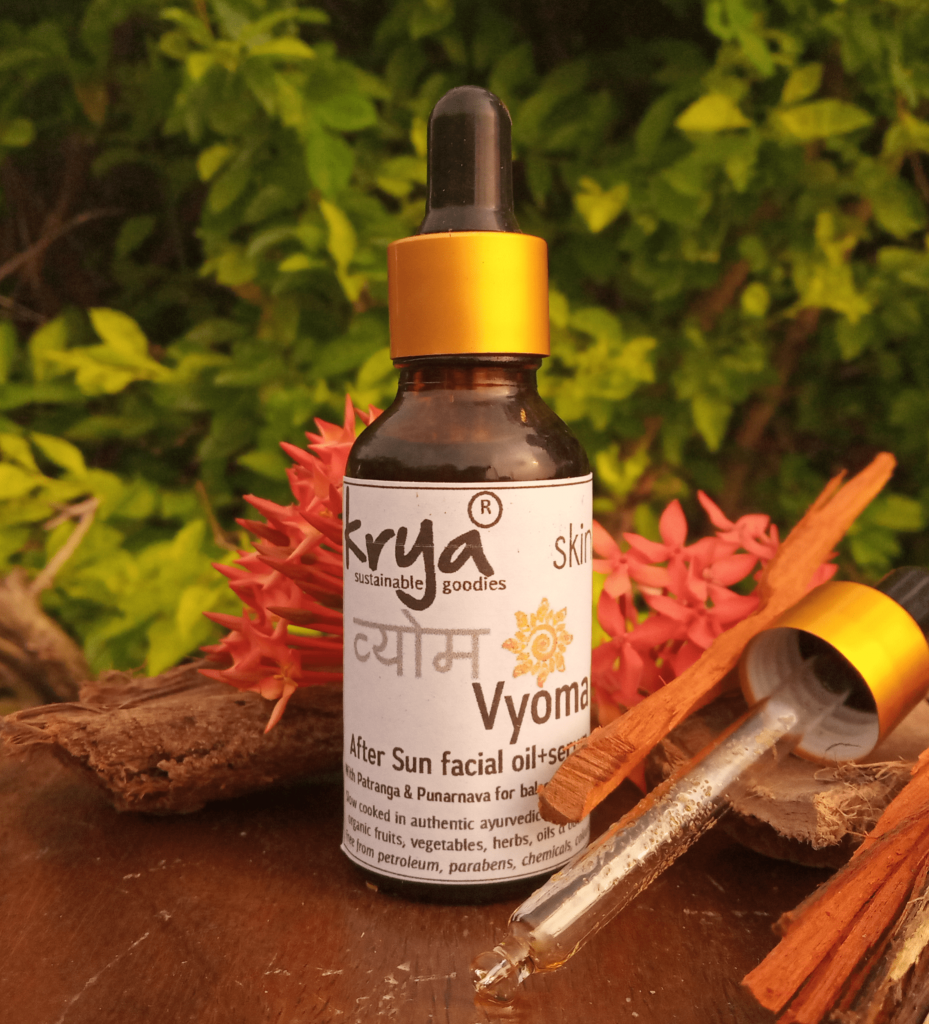
Ayurvedic Lepas from Krya for different skin types:
- Classic Face Lepa – normal to oily skin, with dullness, oily sheen
- Moisture Plus Face Lepa – helps normal to dry skin with lack of lustre, dullness & dryness
- Anti acne Face Lepa – helps adult acne prone skin
- After Sun Face Lepa – helps skin prone to melasma, chloasma, pigmentation and sun tanning & sun sensitivity
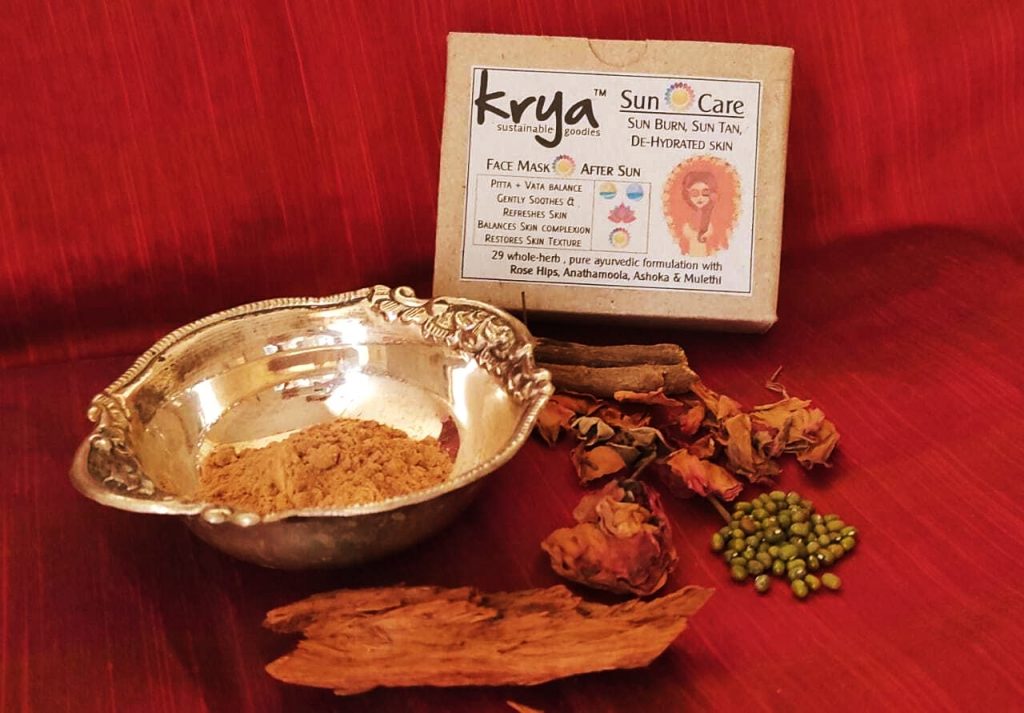
- Teen Anti acne Face Lepa – helps teen acne prone skin or adult cystic acne prone skin
- Men’s Classic Face mask – helps balance sebum, brings in lustre and evenness to Men’s skin which is normal to oily. read here for our ayurvedic Men’s skin care routine.
To sum up: 5 simple face mask tips to enhance your masking experience
Ayurvedic skincare is a deep and holistic subject. It comes from the main medicinal science of Ayurveda which is ancient and of divine origin.. It combines functional skin health along with skin aesthetics – so everything we do for skincare has a deep and long lasting impact. Interestingly most ayurvedic products and regimes are not for a single purpose: we have seen how ayurvedic head oiling helps nourish the eyes and calm the brain. Similarly, many skin care routines help support other organ systems apart from the skin.
As the benefits of each Ayurvedic treatment is so far ranging, the acharyas have given us very specific instructions so that each treatment can work as it is intended. So also in the use of ayurvedic face lepas to help mitigate skin concerns. If used correctly an Ayurvedic face mask does both. It addresses skin concerns. It also regulates and improves the working of the eyes by trapping and drawing out excess Pitta energy from the entire face region.
We hope you enjoyed reading our post on 5 face mask tips to help you enhance your ayurvedic lepa experience. Please download and print out our helpful Lepa checklist to help you with your Lepa and skin goals.
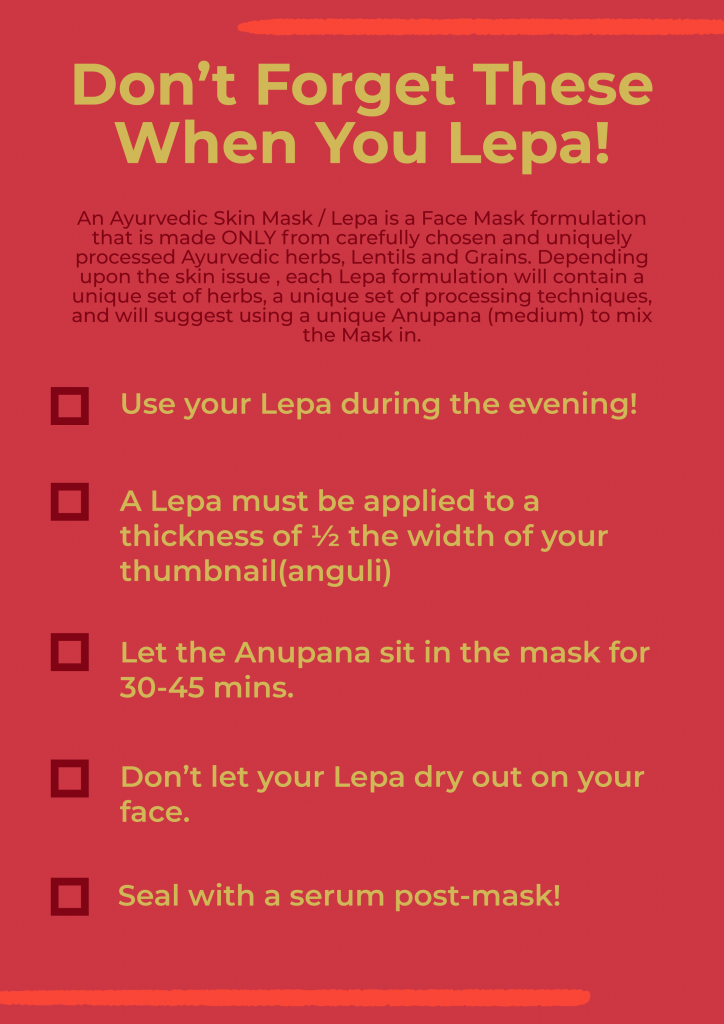
Please explore our wide range of ayurvedic face lepas here. If you would like a product consultation, please DM us on +917550089090 or write to us.

